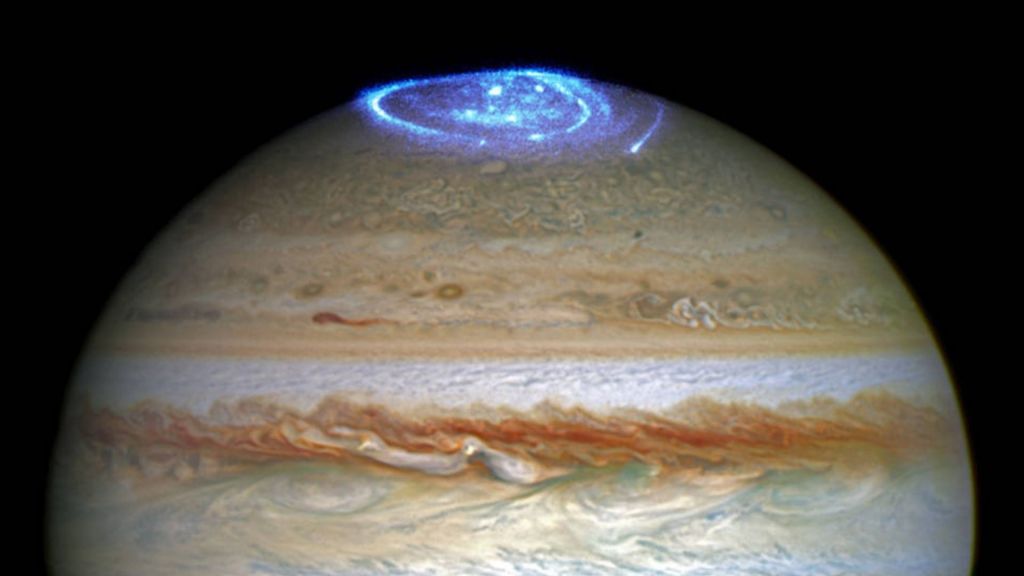Earth’s auroras are among the most breathtaking spectacles on our planet, and yet they pale in comparison to the brilliant light shows that occur over the poles of Jupiter, which produce enough energy to power human civilization for short stints.
For 40 years, scientists have struggled to explain the underlying mechanisms that drive Jupiter’s stunning and luminous auroras, especially the planet’s regular pulses of X-ray light, a phenomenon that has never been seen in the auroras of any other planet in the solar system.
Videos by VICE
Now, a team co-led by Zhonghua Yao, a planetary scientist at the Chinese Academy of Sciences, and William Dunn, a space physicist at University College London, at last “reveal the physical driver for Jupiter’s pulsating x-ray emissions,” according to a study published on Friday in Science Advances. That culprit turned out to be special ripples called electromagnetic ion cyclotron (EMIC) waves, which have been observed here on Earth.
The researchers were able to make this breakthrough by carefully coordinating simultaneous measurements of the aurora with NASA’s Juno probe, which has been orbiting Jupiter since 2016, and the European Space Agency’s X-ray Multi-Mirror Mission (XMM-Newton) observatory, which has been orbiting Earth since 1999. These combined observations enabled the team to search for rhythmic processes inside of Jupiter that might correspond to the consistent periodic X-ray bursts seen in its auroras.
“Jupiter does this weird thing where it pulses regularly, like clockwork,” Dunn said in a call. “We saw that for this interval, Jupiter was pulsing every 27 minutes: it would produce a burst of these bright auroral flares, then it would chill for a bit, and then 27 minutes later, there was another one.”
“That was like a fingerprint, or a smoking gun,” he added. “We knew the aurora was doing that, so we could then go and look at the environment around Jupiter and try and find something that was doing exactly that same process.”
Juno and XMM-Newton first synced up their observations in July 2017, but the hidden mechanism was not immediately obvious to the team. Dunn recalls daily Skype meetings with his colleagues in which they combed through the confusing data and exhausted all possible explanations.
“To our knowledge, there is nothing similar in our solar system planets,” said Yao in an email. “So that, even though we knew something must pulse at the same periodicity as the X-ray, we had no idea where to find these processes.”
Eventually, Yao realized that the flares might be linked to a type of phenomenon known as EMIC waves. When magnetic field lines on a planet such as Earth or Jupiter vibrate, they send ripples through the surrounding plasma, a form of gas in which molecules are split up into electrons and ions. EMIC waves are a product of those interactions between a planet’s magnetosphere and its plasmasphere.

On Earth, these waves cause a rare type of light show called proton aurora. Jupiter’s X-ray auroras, in contrast, are driven in part by the volcanic debris belched out by its lava-drenched moon Io, which pours energetic sulfur and oxygen ions onto the gas giant as it orbits. Jupiter’s EMIC waves carry these ions north and south along magnetic field lines, until they ultimately get dumped into the polar skies and power the X-ray pulses.
Yao, Dunn, and their colleagues were able to connect the timing of Jupiter’s X-ray pulses to the rhythm of its EMIC waves, in much the same way that proton auroras have been linked to the same phenomenon on Earth.
In addition to resolving a decades-long mystery about Jupiter, the new study suggests that EMIC waves may be an underestimated factor in all kinds of interactions between plasma and magnetic fields across the universe.
EMIC waves “might be really important for everything from planets, to solar wind—which is the particles that leave the Sun—to the gas that flows between galaxies,” said Dunn. “That has big consequences for cosmology and understanding how the universe works.”




